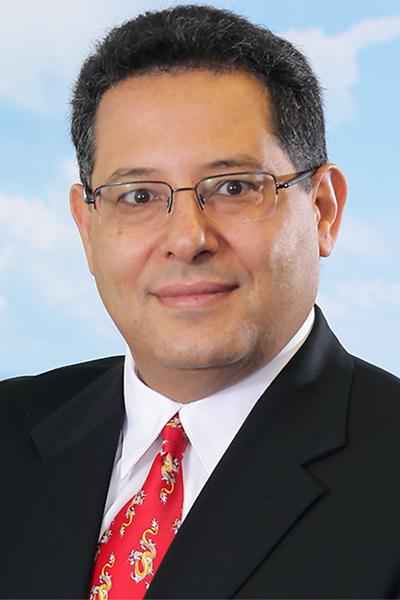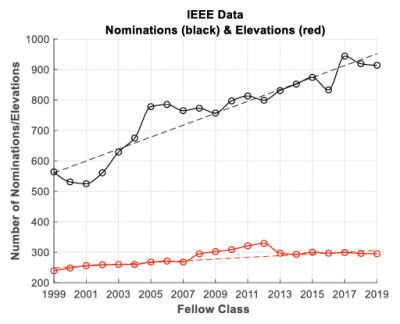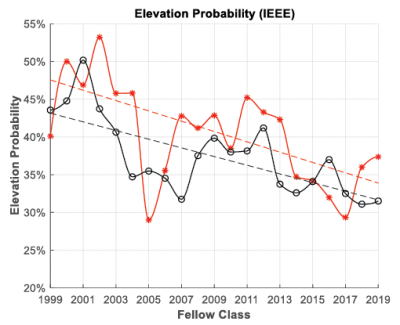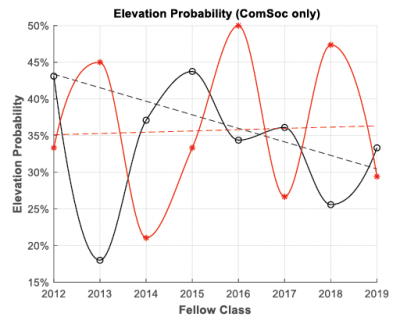IEEE Fellow Elevation for ComSoc Members

IEEE has created many forms of recognition to recognize its members and their contributions in advancing the IEEE’s fields of interest. Among these, the Fellow grade is of great importance. The Fellow grade was established by the American Institute of Electrical Engineers (AIEE), a predecessor of the IEEE, in 1912. It was reserved for members “who had demonstrated outstanding proficiency and had achieved distinction in their profession.” Prospective Fellows had to be at least thirty- two years of age and could directly apply for fellowship. Since that time, the requirements and the process for becoming a Fellow have changed significantly. What has not changed is the extraordinary prestige that the Fellow grade carries.
Today the grade IEEE Fellow is conferred by the IEEE Board of Directors upon a person with an extraordinary record of accomplishments in any of the IEEE fields of interest. First a technical assessment of the Nominee’s accomplishments is performed by the Society/Technical Council (S/TC) Fellow Evaluating Committee (FEC) to which the Nominator referred the Nominee. Then, the IEEE Fellow Committee assesses again the contributions of all Nominees and recommends for elevation to the IEEE Board of Directors the best Nominees. In any year, the number of newly elevated Fellows cannot exceed 0.1% of the total voting IEEE membership. Currently, this corresponds to at most around 350 new Fellows every year and, although there are no quotas for any S/TC, there are typically 30 elevated Nominees every year that have been evaluated by the Communications Society (ComSoc). Additional ComSoc members may also be elevated after being evaluated in other S/TC-FECs.
Over the past few years, ComSoc has dedicated a significant amount of efforts to streamline the Fellow evaluation process with the goal of identifying ways to better support the elevation of our deserving members as well as making sure that all members have the same chance to be elevated irrespective of factors such as gender, employment affiliation, geographical region, etc. Of particular interest is the fair consideration of members with non-academic affiliation (e.g. industry, government) and extraordinary accomplishments in non-research fields (e.g., education).
I have the pleasure to share this article with Robert Schober, the Chair of the ComSoc FEC, along with Stefano Galli, the Chair of the IEEE Fellow Committee and ComSoc Vice-President for Industry and Standards Activities. Our major objective is to outline the Fellow nomination process, the nomination categories, and the evaluation process. Furthermore, we provide a statistical analysis of the past few years.
Robert Schober was a Professor and Canada Research Chair at the University of British Columbia (UBC), Vancouver, Canada, from 2002 to 2011. Since January 2012 he has been an Alexander von Humboldt Professor and the Chair for Digital Communication at Friedrich-Alexander University Erlangen-Nuremberg (FAU), Germany. His research interests fall into the broad areas of communication theory, wireless communications, and statistical signal processing. Robert has received several awards for his work, including a 2001 Heinz-Maier-Leibnitz Award of the German Science Foundation, a 2007 Wilhelm Friedrich Bessel Research Award of the Alexander von Humboldt Foundation, the 2008 Charles McDowell Award for Excellence in Research from UBC, a 2011 Alexander von Humboldt Professorship, a 2012 NSERC E.W.R. Stacie Fellowship, and the 2017 Wireless Communication Technical Committee Recognition Award. In addition, he has received several best paper awards for his research and is listed as a Highly Cited Researcher by the Web of Science. Robert is a Fellow of the Canadian Academy of Engineering, a Fellow of the Engineering Institute of Canada, and a Fellow of the IEEE. From 2012 to 2015, he served as Editor-in-Chief of IEEE Transactions on Communications. Currently, he serves on the Editorial Board of the Proceedings of the IEEE, as the ComSoc Director of Journals, and as the ComSoc Fellow Evaluation Committee Chair. For his service to ComSoc publications, he received the 2018 IEEE ComSoc Joseph Lo Cicero Award for Exemplary Service to Publications.
Dr. Stefano Galli is ComSoc’s Vice-President for Industry and Standards and will serve through the end of 2019. He has been a Lead Scientist at Huawei Technologies, New Jersey, since 2016. In his previous positions, he served as Director of Technology Strategy in ASSIA, Director of Energy Solutions R&D for Panasonic Corporation, Senior Scientist at Bellcore, and independent consultant. In his carrier, he worked on several standards, submitting numerous contributions to IEEE, ITU-T, ETSI, ETSI-NFV, BBF, ATIS, and NICC. He currently serves as Rapporteur (Chair) of the ITU-T “Communications for Smart Grid” standardization group and has served as Co-Chair of the “Communications Technology” Task Force of the IEEE 2030 Smart Grid standard, and Co-Leader of the “Theoretical and Mathematical Models” Sub-Group of the IEEE 1901 Broadband over Power Lines standard. He is a Fellow of the IEEE and is currently serving in his second term as the IEEE Fellow Committee Chair. He has received the IEEE ISPLC Best Paper Awards in 2010 and 2015, the 2014 Broadband Forum Outstanding Contributor Award, the 2013 IEEE Donald G. Fink Best Paper Award, the 2011 IEEE ComSoc McLellan Meritorious Service Award, and the 2011 Outstanding Service Award from the IEEE ComSoc Technical Committee on Power Line Communications. He has also served as the first Chair and Founder of the IEEE Communications Society Technical Committee on Powerline Communications. He holds 27 issued/pending patents, has co-authored 110+ papers, and has co-authored one book and several book chapters. He received his Ph.D. in electrical engineering from the University of Rome (Italy) in 1998.
The Fellow Nomination Process
Each nomination involves a Nominee, a Nominator, three to five References, and up to three Endorsers. To be eligible, the Nominee must:
- be an IEEE Senior/IEEE Life Senior Member;
- have been a member in good standing and has completed a minimum of five full years (consecutive or not) of IEEE membership in any grade preceding January 1 of the year of elevation;
- have accomplishments that have contributed importantly to the advancement or application of engineering, science and technology, bringing the realization of significant value to society.
The References must be IEEE Fellows (with an exception when both Nominee and Reference are from Region 9), while the Nominator and the Endorsers do not. The Nominator should be somebody who is well aware of the extraordinary accomplishments of the Nominee and the References should be in a position to judge these accomplishments. The nomination must identify and provide verifiable evidence for the Nominee’s extraordinary contributions to the advancement or application of engineering, science, and technology as well as their significant impact on society at large. Endorsements allow the presentation of additional evidence of technical impact for contributions that may have been proprietary at the time they were developed or not available for citation in the open literature. The nomination and all supporting letters must be received by the IEEE by March 1 of the year preceding the year of elevation. A well written nomination providing clear evidence for the Nominee’s accomplishments is the key to a successful nomination. Detailed information on how to write an effective nomination can be found here: https://www.ieee.org/content/dam/ieee-org/ieee/web/org/about/fellows/fellows-nominations.pdf. Other useful Fellow Guides can be found on the Fellow homepage at https://www.ieee.org/fellows.
The Fellow Nomination Categories
The IEEE Fellow evaluation process is designed to provide equal recognition to theoretical development and practical contributions in the application of engineering, science, and technology. This is accomplished by setting different evaluation criteria for the four Fellow Nomination categories, namely Application Engineer/Practitioner, Educator, Research Engineer/Scientist, and Technical Leader. A description of these Fellow categories and the share they account for among all IEEE nominations is given below:
- Application Engineer/Practitioner (AE/P, 6%): A professional working on design and/or evolution into manufacturing of products or systems; the use, operation, or application of such products or systems; and the advancement of industry practices and standards. The focus of the evaluation is on innovativeness, originality, creativity, meeting market needs, regional as well as global impact on the profession or society at large, and advances in quality, reliability, cost effectiveness, and manufacturability.
- Educator (EDU, 4%): Typically, a teacher or an administrator who has made an impact on education. Focus is on the uniqueness, innovation, and degree of acceptance of the Nominee’s contributions.
- Research Engineer/Scientist (RE/S, 80%): This is typically an academic or professional in corporate/government R&D working on the advancement of the state-of-the art of a technology or the understanding of a theoretical problem. Evaluation focus is on inventions, discoveries, or advances in the state of the art made by the Nominee, all of which must confirm innovation, creativity, impact, and a distinct personal role of the Nominee.
- Technical Leader (TL, 10%): A professional in corporate/ government technical management, or leading large transformational multi-party projects in industry, academia, or government. Contributions take the form of application-oriented or scientific accomplishments from leading technically a team or a company- wide effort. The focus of the evaluation is on technical innovation and creativity involving ‘difficulties’ and ‘risks’ which were resolved through the technical leadership role of the Nominee.
The category best suited for a Nominee does not depend on the Nominee’s employment affiliation type (e.g., academia vs. industry) but on the type of contributions made, the available evidence of contributions, and the contributions’ impact. The type of evidence considered during the evaluation depends on the Fellow category. For example, peer-reviewed publications and citations often play an important role for Nominees in the Research Engineer/Scientist category, while they are not expected for Nominees in the other three categories. Citation information is carefully analyzed. Citation metrics can be informative, but they are not the primary consideration in the assessment of the impact of a Nominee’s contribution. Furthermore, citation counts for highly influential articles may differ substantially across technical areas, and a survey paper may have many more citations than a research contribution even though technical contributions are generally more influential.
The Fellow Evaluation Process
The evaluation process has three stages. In the first stage, all Nominees are evaluated and ranked by the Fellow Evaluation Committee (FEC) of the S/TC the Nominee has been referred to by the Nominator. The responsibility of an S/TC-FEC is to provide the IEEE Fellow Committee with a critical technical evaluation of a Nominee’s contribution and an assessment of the degree of qualification of the Nominee. In the FEC evaluation, only a technical evaluation of a Nominee’s contributions must be performed while disregarding other service to IEEE which is taken into account by the IEEE Fellow Committee. It is also noted that the S/TC FECs do not have access to the Reference letters, which are seen only by the IEEE Fellow Committee.
The S/TC FECs forward to the IEEE Fellow Committee their rankings along with a numerical score and a narrative justifying the rank and score assigned to each Nominee. In the second stage, the IEEE Fellow Committee ranks the Nominees across all S/TCs and then sends the list of Nominees recommended for elevation to the IEEE Board of Directors. In the final stage, the IEEE Board of Directors makes the final decision on who is elevated and announces the newly elevated Fellows in the third week of November of every year.
ComSoc’s Evaluation Process
ComSoc typically receives around 90 nominations per year, ranging from 80 to 110 in the past eight years. Each nomination is reviewed by at least five FEC members (evaluators). When assigning evaluators to Nominees, potential conflicts of interest are carefully avoided. The evaluators are asked to assign a score between 1 and 4 to each nomination. The Nominee’s scores are then averaged, leading to an initial ranking of the Nominees. The scores and the resulting ranking are then discussed and consolidated in multiple FEC meetings. When these discussions have converged, the final ranking along with the numerical score and narrative for each Nominee are passed on to the IEEE Fellow Committee. Since S/TC FECs and the IEEE Fellow Committee have different roles in the process and the IEEE Fellow Committee looks at all Nominees across all S/TCs, it is not surprising that the S/TC rankings will often differ from the final IEEE ranking.

IEEE and ComSoc Elevation Statistics
The available data goes back to 1999 for all IEEE Nominees, and back to 2012 for ComSoc Nominees. Here, the year indicates the Fellow Class, i.e. the year
of elevation.
The trend of nominations and elevations across IEEE is shown in Figure 1. While the number of Fellow elevations (which are tied to the IEEE voting membership) has grown slightly in the past 20 years, the number of nominations has grown substantially reaching almost 1,000 Nominees.

An immediate consequence of this trend is that the probability of elevation across all of IEEE has been steadily decreasing over time, thus confirming the general perception of many IEEE Members that becoming an IEEE Fellow was becoming more and more difficult. This is shown in Figure 2, where the elevation probabilities of IEEE as a whole are compared to that of ComSoc alone. Here it is also possible to see that ComSoc Nominees usually do rather well compared to IEEE and, in fact, ComSoc’s elevation probability five-year average is 34.6% while the IEEE average is 33.2%. ComSoc nominations are dominated by the RE/S category, which accounts for 77% of all ComSoc nominations. For the other categories, we have TL at 13%, AE/P at 7%, and EDU at 3%. This is in line with the overall IEEE statistics. We also point out that ComSoc nominations account for:
- The largest share of all TL nominations across IEEE (13%), followed by the Power & Energy (11.8%) and Computer (9.8%) Societies.
- The second largest share of all RE/S nominations across IEEE (10%), second to the Computer Society (14%) and followed by the Signal Processing Society (8%).
- The third largest share of all AE/P nominations across IEEE (11%), after the Power & Energy (22%) and Industrial Applications (15%) Societies.
- The fourth largest share of all EDU nominations across IEEE (9%), after the Education (20%), Power & Energy (10%), and Computer (9.6%) Societies.
IEEE and ComSoc Elevation Statistics Conditional to the Nominee's Employment Type
It is interesting to see how the probability of elevation of IEEE and ComSoc Nominees with diff erent types of employer varies. In the nomination form, four employment types are collected: Academia, Industry, Government, and Other. Table 1 reports IEEE and ComSoc 2012-2019 average elevation probabilities. There are much fewer Government and Other Nominees in ComSoc than those from Academia and Industry and this is refl ected in the very high 95% Confi dence interval. This makes the average elevation probability estimate very unreliable for Government and Other Nominees. Looking at the IEEE averages, we see that Nominees from Academia, Industry, and Government have similar elevation probabilities. Nominees in Other have a high confi dence interval which does not allow us to draw defi nitive conclusions. Finally, we note that Industry Nominees have the highest elevation probability of all employment types both in IEEE and in the ComSoc subset.
| Academia | Government | Industry | Other | |
|---|---|---|---|---|
| ComSoc Average EP |
33.9% ± 7.2% | 28.2% ± 22.0% | 35.8% ± 8.8% | 19.1% ± 35.0% |
| IEEE Average EP |
34.2% ± 2.8% | 35.7% ± 4.4% | 36.2% ± 4.0% | 30.9% ± 15.1% |

We now look specifically at how academic and industry Nominees perform in IEEE and ComSoc. The elevation probability for these categories are shown in Figure 3 for IEEE data and in Figure 4 for ComSoc data.
Contrary to common belief, Figure 3 shows that industry Nominees usually perform better than academic Nominees. Furthermore, the slope of the trendline of the elevation probability versus time for industry Nominees is only slightly steeper than that for academic Nominees, signaling that academic and industry Nominees suffer similarly from the overall elevation probability decreasing trend shown earlier in Figure 2.

For the ComSoc case, we note a peculiar oscillatory behavior where better performances of one category seems often to imply poorer performances in the other category. Although this oscillatory behavior makes trend analysis challenging, we point out that, differently from the IEEE case, industry Nominees in ComSoc do not seem to experience a steep decreasing trend that IEEE industry Nominees experience.
IEEE and ComSoc Elevation Statistics Conditional to the Nomination Category
Let us now look at the probability of elevation of IEEE and ComSoc Nominees nominated in the four Fellow nomination categories. Table 2 reports IEEE and ComSoc 2012-2019 average elevation probabilities for AE/P, EDU, RE/S, and TL Nominees.
Differently from the case of employment type (see Table 1), we notice here that there are big differences between the elevation probabilities of different Fellow nomination categories, both in IEEE and ComSoc data. Clearly, RE/S Nominees in ComSoc and RE/S and TL Nominees in all IEEE have much better chances of being elevated compared to AE/P and especially EDU Nominees. This behavior was also reported in a recent article in The Institute [1].
| AE/P | EDU | RE/S | TL | |
|---|---|---|---|---|
| ComSoc Average EP |
24.0% ± 17.0% | 13.5% ± 16.6% | 37.4% ± 6.3% | 23.4% ± 11.5% |
| IEEE Average EP |
26.2% ± 4.9% | 20.6% ± 2.7% | 36.0% ± 3.0% | 36.0% ± 4.1% |
Final Considerations
The presented results show that Nominees perform similarly regardless of their employment affiliation. However, there is a big difference in performance across Fellow nomination categories. Is this because of bias in the evaluation? Or is the process inherently unfair to those categories? Data analysis cannot answer all questions and, even if statistical anomalies are detected, not necessarily root causes are identified. There are many plausible interrelated causes (in addition to possible bias) that could explain why scientists (whatever their employment type) outperform non-scientists in Fellow elevation. An assessment of those causes cannot be reported here for lack of space, and the reader is referred to The Institute article referenced below.
In this issue we publish the photos and citations for the 2019 Class of Fellows who are members of the Communications Society. See pages 8-10.
Reference
[1] S. Galli and A. Reibman, “Analysis Shows No Evidence of Bias Against Fellow Nominees from Industry,” The Institute, Nov. 20, 2017; http://theinstitute.ieee.org/members/ieee-groups/analysis-shows-no-evidence-of-bias-against-fellow-nominees-from-industry.


